The Ultimate Dairy-Free Scalloped Potatoes: Creamy, Flavorful, and Gluten-Free Perfection
Imagine layers of tender, pillowy potatoes, lovingly bathed in a rich, homemade white sauce, then baked to golden-brown excellence in a trusty skillet. This isn’t just a side dish; it’s a culinary masterpiece. These Dairy-Free Scalloped Potatoes redefine comfort food, offering a decadent, no-fail vegan and gluten-free experience that will utterly delight your guests. Whether you’re planning a grand Thanksgiving feast or simply elevating a routine weeknight meal into something extraordinary, this recipe promises to impress with its incredible depth of flavor and irresistibly creamy texture.
For more inspiring and wholesome holiday dishes, explore my comprehensive Thanksgiving Recipe Roundup.
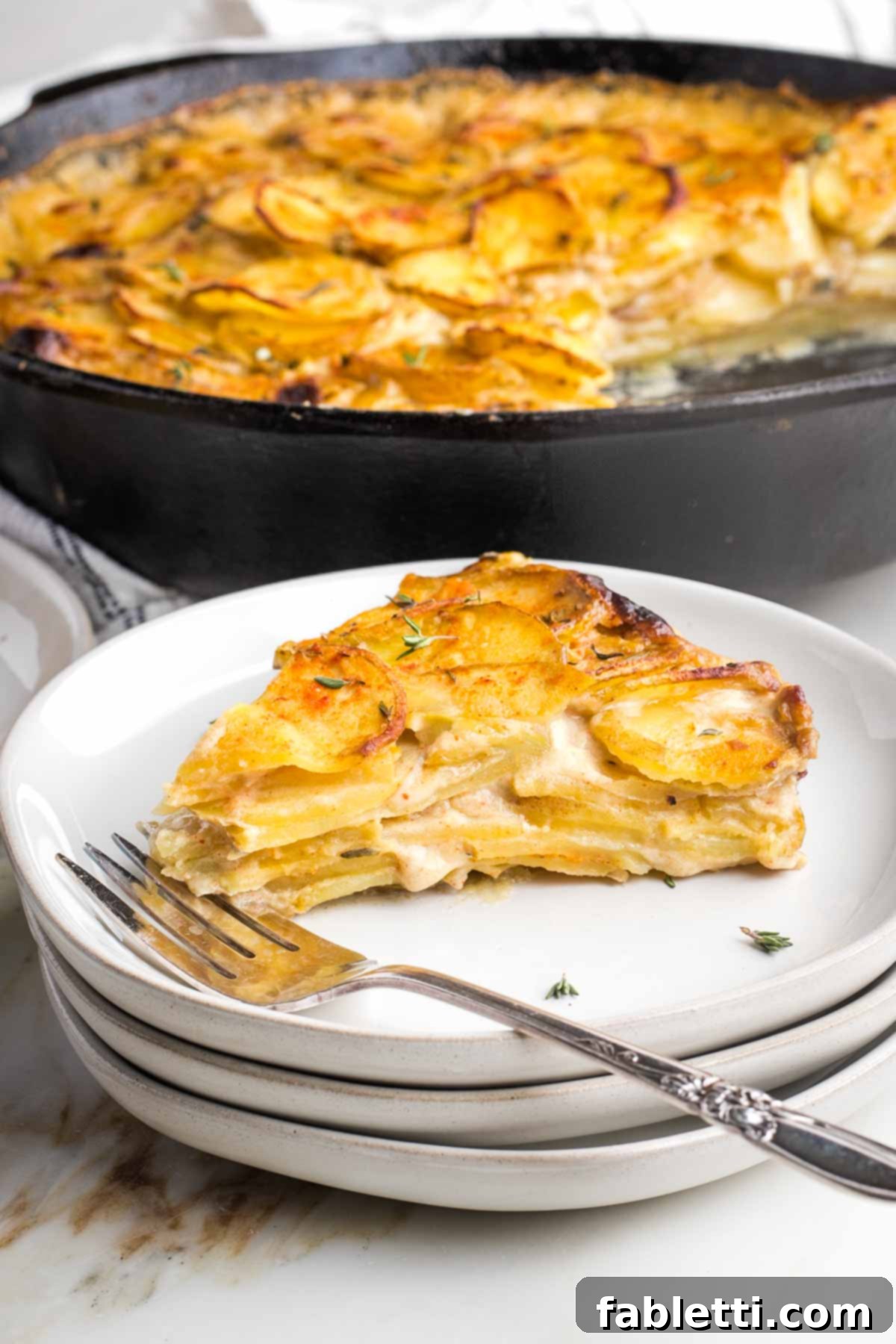
Why You’ll Adore These Dairy-Free, Gluten-Free Scalloped Potatoes
Prepare to fall in love with these gluten-free and dairy-free scalloped potatoes. They are not merely delicious; they are a revelation, proving unequivocally that dietary restrictions never have to compromise on taste or indulgence. Crafted with a meticulous eye for flavor and texture, this recipe captures the essence of classic scalloped potatoes while being entirely plant-based and gluten-free, ensuring everyone at your table can savor its exquisite taste. We champion a philosophy of wholesome, simple ingredients, combined with smart culinary techniques, to deliver a dish that’s miles away from the bland, mushy, or boring potato casseroles of the past. Forget those disappointing experiences; with this recipe, every forkful is a celebration of creamy, savory perfection.
The notion that “dairy-free” means sacrificing great taste is firmly debunked by this fabulous vegan potato side dish. It’s a testament to how thoughtfully chosen ingredients and a refined cooking process can create a truly memorable meal. Follow along as we guide you through crafting savory, deeply satisfying, and indeed, dairy-free scalloped potatoes that are guaranteed to become a new favorite.
The Art of the Vegan Béchamel: Our Secret Creamy Sauce
At the heart of any exceptional scalloped potato dish lies a truly magnificent white sauce. In this recipe, we’ve taken my beloved dairy-free béchamel and elevated it with strategic savory seasoning adjustments and the addition of rich veggie broth. The results are nothing short of stunningly delicious. My husband, a discerning critic, enthusiastically rated this dish 11 out of 10 and gave it a resounding thumbs-up for inclusion on our Thanksgiving menu – a truly high honor!
While often confused, the primary distinction between scalloped potatoes and an au gratin recipe typically lies in the cheese topping characteristic of au gratin. If you find yourself craving that cheesy gratification, I highly recommend trying my creamy vegan parsnip au gratin, which delivers genuine cheesy satisfaction without any dairy. However, for those seeking pure, unadulterated potato comfort enveloped in a luscious, dairy-free cream sauce, these scalloped potatoes are the ultimate choice.
Ingredients Unveiled: Crafting Flavorful Dairy-Free Scalloped Potatoes

Selecting the right ingredients is paramount to achieving the perfect balance of flavor and texture in your dairy-free scalloped potatoes. Each component plays a vital role in creating this incredibly satisfying dish:
- Potatoes: The foundation of our dish. For the creamiest scalloped potatoes, opt for starchy varieties like Yukon Gold, King Edward, or Russet potatoes. These varieties break down slightly during baking, releasing their starches to create a naturally thicker, more luxurious sauce. Alternatively, Red Bliss potatoes are an excellent choice if you prefer potatoes that hold their shape beautifully, contributing to a distinct, appealing layered aesthetic in the final dish. The key is uniform, thin slicing, regardless of the potato type.
- Plant Milk: This is the cornerstone of our rich, dairy-free white sauce. Virtually any plant-based milk will perform admirably in this recipe, allowing you to choose based on your dietary preferences and needs. Soy, oat, and cashew milk are particularly well-suited due to their relatively neutral flavor profiles and creamy textures, which blend seamlessly into the sauce without overpowering the other ingredients. Almond milk also works beautifully, as used in the recipe card below.
- Miso Paste: A true flavor secret weapon in vegan cooking. This fermented soybean paste is a fabulous umami enhancer, lending a deep, savory, almost meaty richness to the white sauce without any animal products. It’s what gives our sauce that irresistible depth that makes this dish so remarkably satisfying.
- Nutritional Yeast: Affectionately known as “nooch,” this ingredient provides a subtle yet distinct cheesy flavor that elevates the overall profile of the dish. It’s entirely optional, so if you’re not a fan of its unique taste, feel free to omit it without compromising the core integrity of the recipe. However, it does add a fantastic dimension.
- Fresh Herbs: Fresh herbs bring an aromatic brightness and complexity that dried herbs simply can’t match. I personally adore fresh thyme, which is surprisingly easy to cultivate year-round in a windowsill garden. Excellent substitutions include fresh parsley, basil, or oregano. If fresh herbs are unavailable, a high-quality dried Italian seasoning blend can be used as an alternative, though you might need a bit more to achieve a similar aromatic impact.
- Veggie Broth: This liquid gold contributes significant savory notes and forms the base of our béchamel. I highly recommend using my easy homemade veggie broth recipe for the freshest and most control over ingredients. Batch-preparing and freezing it in one-cup increments ensures you always have it on hand. If purchasing store-bought broth, always scrutinize the label for sodium content. Store-bought versions are often heavily salted, so you may need to adjust or entirely omit the added salt in this recipe to prevent it from becoming overly salty.
- Cassava Flour: A fantastic gluten-free alternative for thickening our white sauce. Cassava flour offers a neutral taste and contributes a smooth, velvety texture without any grittiness. It’s also often praised for its higher fiber and protein content compared to traditional wheat flour. If cassava flour isn’t accessible, a gluten-free all-purpose flour blend or even regular all-purpose flour (if gluten isn’t a concern) can be used as a substitute.
- Olive Oil: Used to create the roux, the initial thickening agent for our sauce. Olive oil adds a mild, fruity flavor and helps achieve that essential creamy consistency.
- Garlic: Freshly grated garlic infused into the roux provides an essential aromatic base that builds the savory profile of the white sauce.
- Paprika, Sea Salt, and Black Pepper: These fundamental seasonings are crucial for balancing and enhancing all the other flavors, ensuring each layer of potatoes is perfectly seasoned and delicious.
A Step-by-Step Culinary Guide: Crafting Your Dairy-Free Scalloped Potatoes
Embark on your journey to create these incredibly delicious dairy-free scalloped potatoes with confidence. The process is broken down into manageable steps, ensuring a smooth and enjoyable cooking experience.
Mastering the Creamy Vegan White Sauce
The luscious white sauce is the heart of this dish. Its creamy texture and savory depth are what transform simple potatoes into an extraordinary culinary experience.
- Begin by preparing your miso paste. Take a couple of tablespoons of the plant-based milk (or veggie broth) and mix the miso paste thoroughly with a fork until it forms a smooth, consistent mixture. This crucial step ensures the miso dissolves evenly into the sauce later, preventing any lumps and distributing its umami flavor perfectly. Set this mixture aside for now.
- Heat the olive oil in your cast iron skillet over medium-low heat. Once warm, sprinkle in the cassava flour. Immediately begin whisking vigorously. Continue whisking constantly for 1-2 minutes until a thick, golden paste, known as a roux, forms. This roux is what will thicken our sauce.
- Pour in about ¼ cup of the veggie broth and continue whisking until it is fully incorporated into the roux and the mixture is smooth. Next, add the finely grated garlic and stir constantly for approximately 30 seconds, allowing its fragrant aroma to develop without browning.
- Now, you’ll gradually build your sauce. Begin by adding about ¼ cup of plant milk, whisking it into the roux until completely smooth and thickened. Alternate between adding ¼ cup of veggie broth and ¼ cup of plant milk, whisking thoroughly after each addition. Be patient; the sauce will fluctuate between thicker and thinner consistencies as you add liquid, eventually becoming beautifully smooth and creamy.
- Once all the milk and broth have been incorporated, stir in the reserved miso paste mixture, along with half of the paprika, half of the sea salt, and half of the black pepper. Whisk everything together until thoroughly combined and the sauce is wonderfully thick and creamy, yet still pourable. It should have a slightly drippy consistency, which is ideal for coating and cooking the potato slices. Carefully pour this exquisite white sauce into a separate bowl or a large measuring cup. You should have approximately 2 ¾ cups of this savory liquid gold.
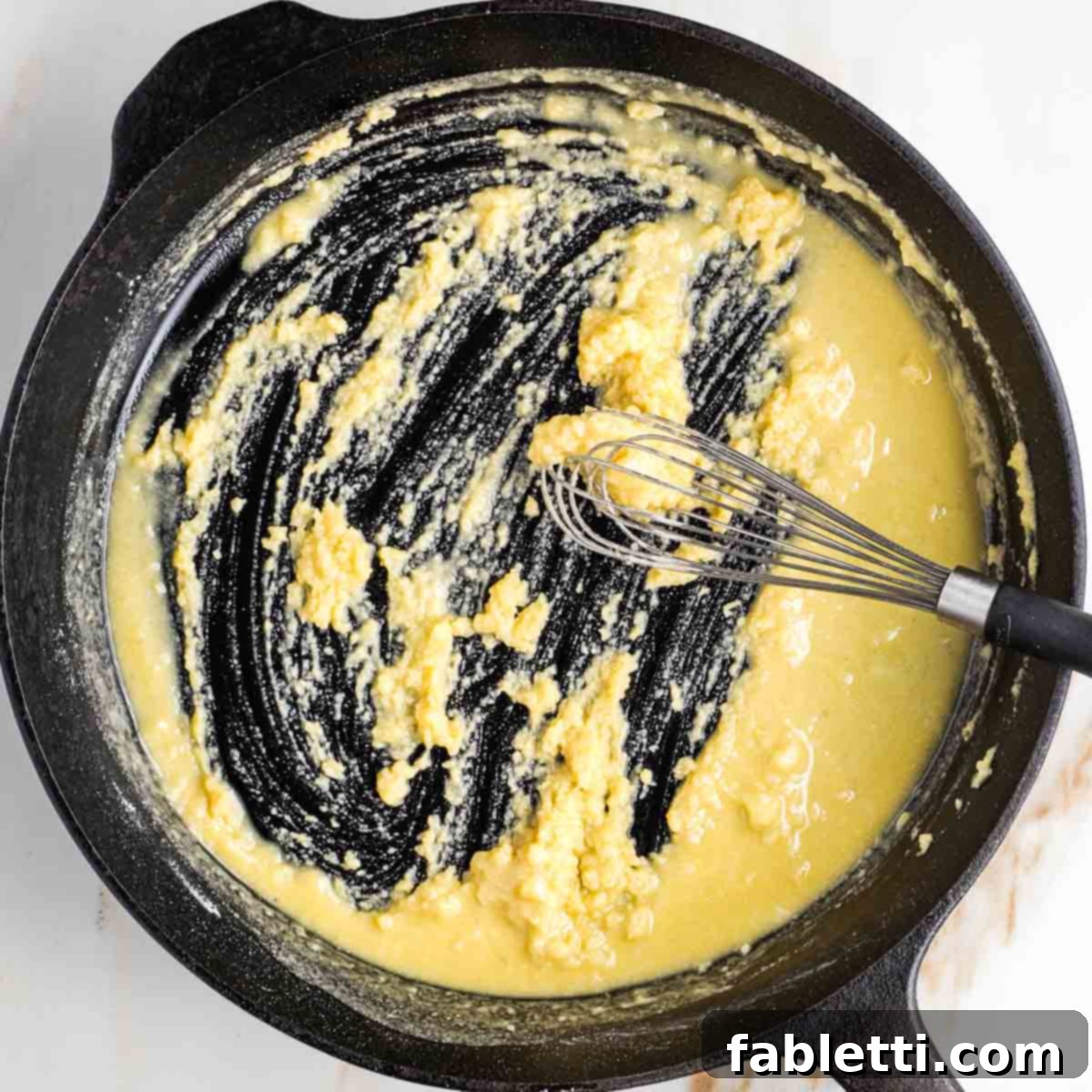
The journey to creamy perfection starts with a perfectly executed roux. Heat the olive oil in a cast iron skillet over medium-low heat. Sprinkle on the cassava flour and whisk continuously until a thick, uniform paste is formed, ready to absorb the liquids.
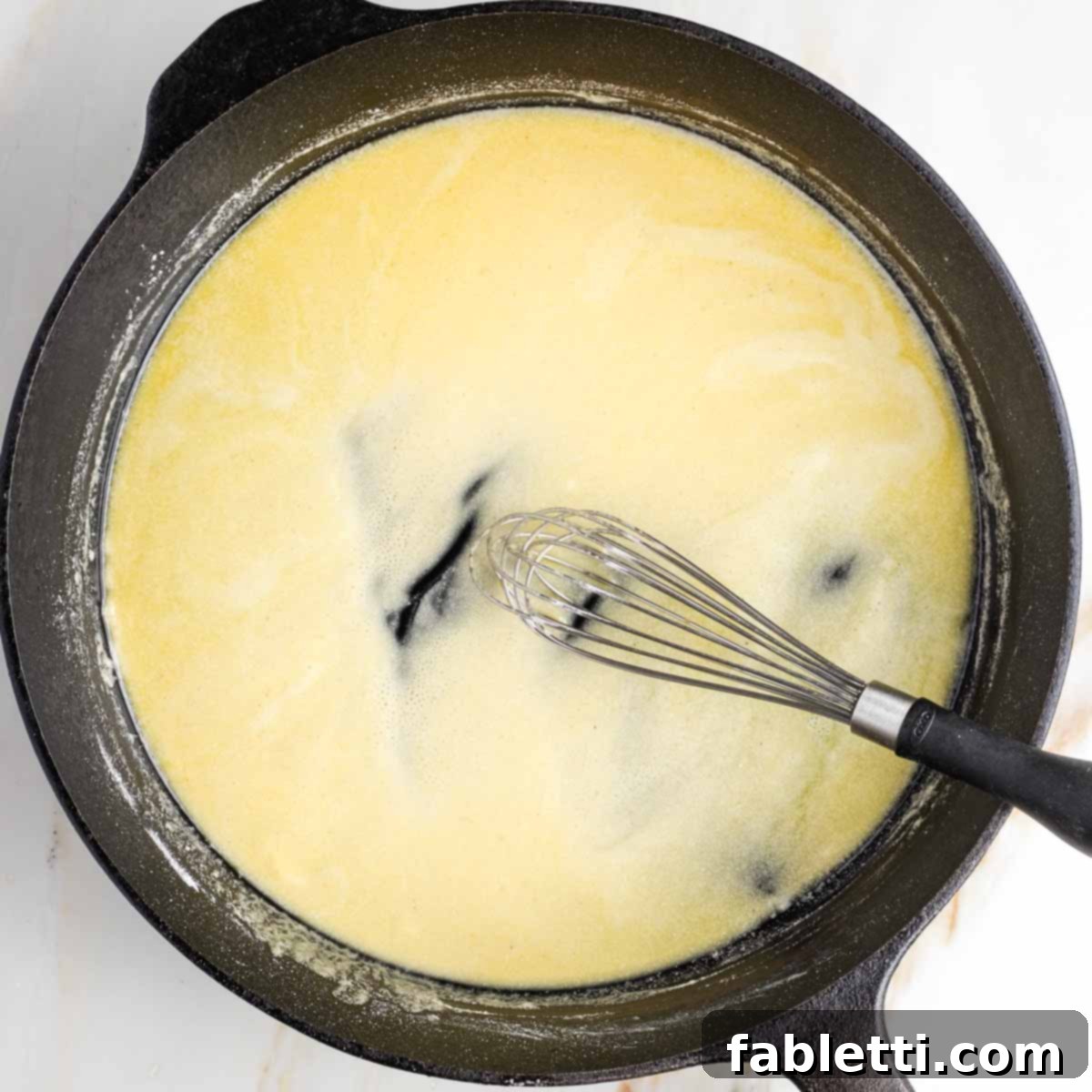
Introduce the first two tablespoons of veggie broth to the roux and continue whisking until thoroughly combined. Then, add the fragrant grated garlic and stir constantly for about 30 seconds until its inviting aroma permeates the kitchen, building the foundational flavor of your sauce.
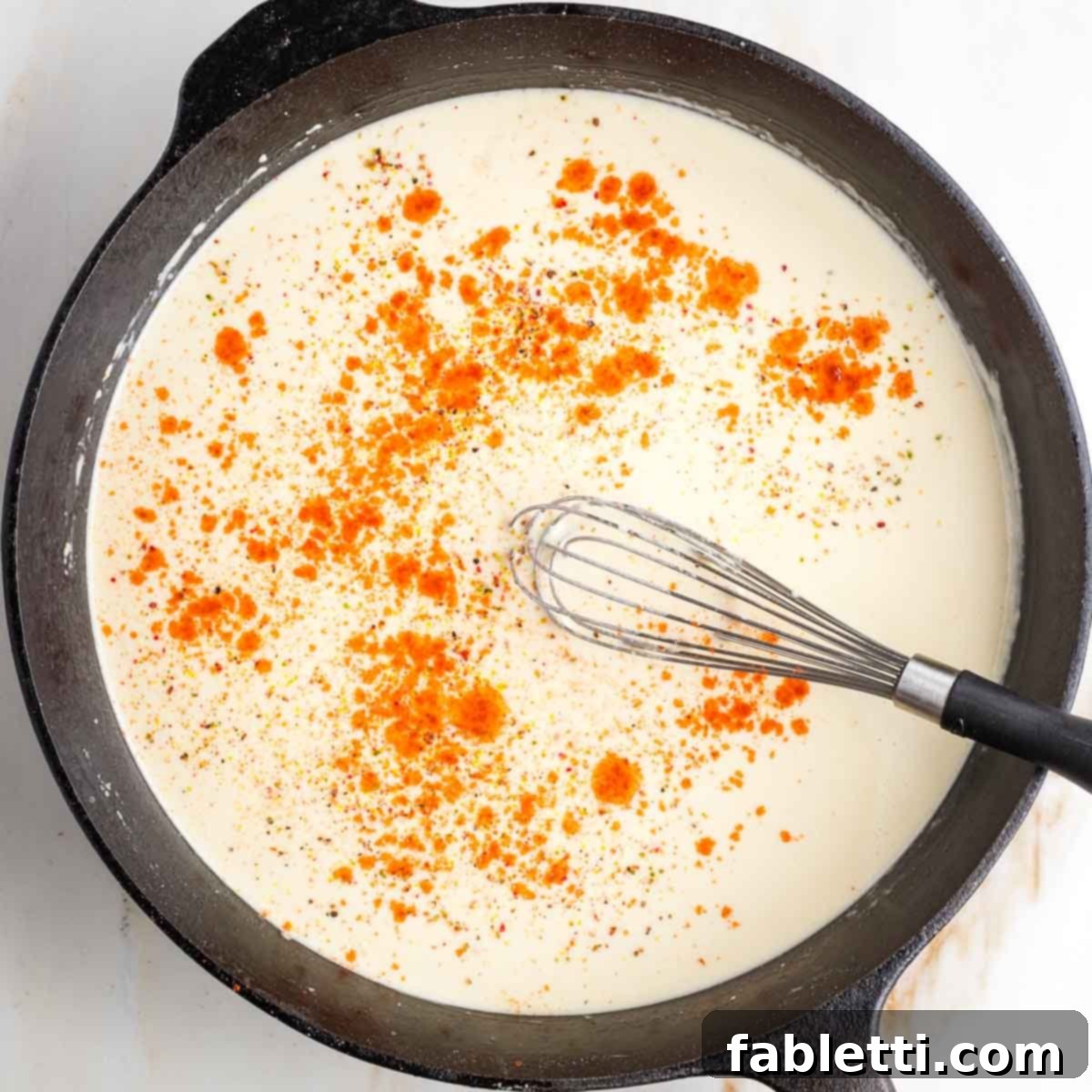
Continue the process of adding liquid, alternating between broth and milk, approximately ¼ cup at a time. Whisk thoroughly after each addition. Observe as your white sauce transforms, thickening and thinning in stages until all the liquid is absorbed. Finally, incorporate the miso paste mixture, paprika, salt, and pepper.

Whisk meticulously until all ingredients are seamlessly incorporated and the sauce achieves a thick, creamy consistency. It should still be slightly drippy, which is precisely the perfect texture for enrobing the potato slices during baking. Transfer the sauce to a separate bowl or a large measuring cup; you will have roughly 2 ¾ cups of this exquisite creation.
Preparing and Layering the Potatoes
The visual appeal and textural perfection of scalloped potatoes come from careful potato preparation and strategic layering.
- Preheat your oven to 350 degrees Fahrenheit (175°C).
- Wash your potatoes thoroughly, scrubbing them well to remove any dirt or debris. There’s no need to peel them; the skins add a rustic charm and extra nutrients. For consistent thickness, which is crucial for even cooking, use a mandoline or a food processor with a slicing disc to cut them to a uniform ⅛-inch thickness. If cutting by hand, strive for consistent, thin slices. It may seem like an overwhelming amount of potatoes, but they will wonderfully collapse and fit snugly into your skillet.
- Now comes the satisfying part: shingling your potato slices! This technique involves overlapping the slices, much like roof shingles, creating a cross-hatch or spiral pattern. This method ensures that every potato slice has ample opportunity to absorb the creamy sauce and bake to tender perfection, while also allowing some edges to crisp up beautifully.
- Use the same cast iron skillet you used to prepare the sauce. Begin the bottom layer by arranging individual potato slices against the sides of the skillet, slightly overlapping them. Once you’ve completed this outer circle, start on the next layer, continuing to overlap in all directions, working your way towards the center.
- When you reach the center of this first layer, sprinkle a portion of the remaining salt, pepper, paprika, and a few sprigs of fresh thyme over the potatoes. This ensures flavor penetrates throughout the layers.
- Complete this first layer by pouring about ¾ cup of your creamy white sauce evenly over the potatoes. Then, generously sprinkle with about one teaspoon of nutritional yeast for that subtle cheesy note. This marks the completion of layer one.
- Continue building your scalloped potatoes by repeating the layering process. Start a new layer of the overlapping spiral pattern, placing potatoes on the outside edge first and gradually adding circular layers towards the center. Intersperse each potato layer with sprinkles of the remaining spices, additional sauce, and a touch more nutritional yeast until all your ingredients have been used up. The top layer should be covered with the remaining sauce and a final sprinkle of nutritional yeast.
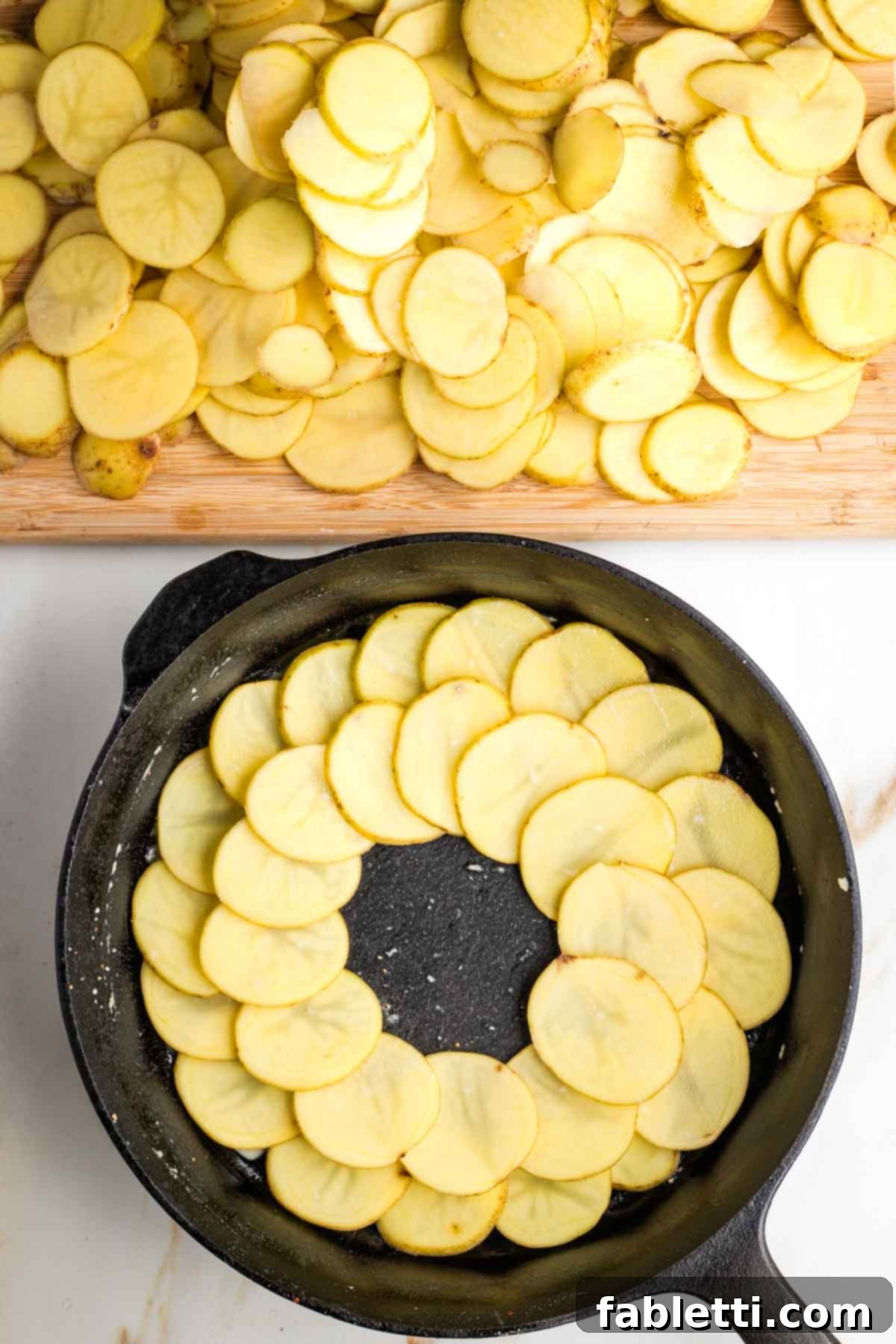
Utilize the same skillet in which you crafted your exquisite sauce. Initiate the base layer by carefully placing individual potato slices against the skillet’s sides, ensuring a slight overlap. Following this initial circular arrangement, proceed with the subsequent layers, continuing the overlapping pattern in all directions.

Upon reaching the center of your potato layer, distribute a light dusting of the remaining salt, pepper, paprika, and fresh herbs over the potatoes. This thoughtful seasoning ensures that every bite is infused with balanced and aromatic flavor.
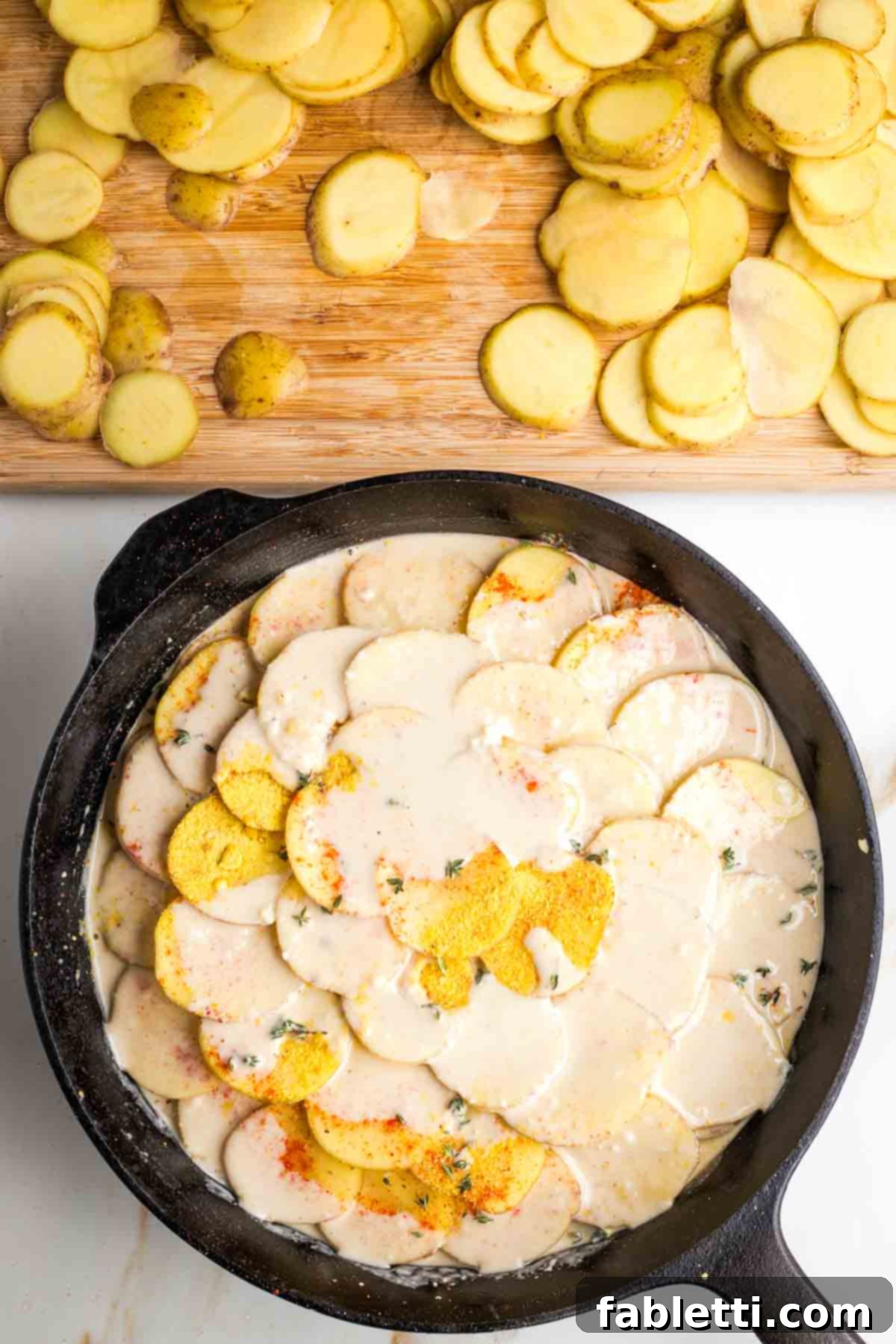
To finalize the first layer, carefully pour about ¾ cup of the homemade sauce over the potatoes, ensuring even distribution. Follow this with a sprinkle of nutritional yeast. This completes the foundational layer, ready for the next iteration of deliciousness.

Proceed to build subsequent layers, recreating the overlapping spiral pattern with potatoes, starting from the outer edge and spiraling towards the center. Continue this delightful layering process with potatoes, spices, sauce, and nutritional yeast until all your ingredients are skillfully utilized, building a towering masterpiece.
The Perfect Bake: Achieving Tender Potatoes with a Crispy Top
- Cover the skillet tightly with aluminum foil. This step is absolutely essential for perfectly tender potatoes. If your skillet or baking dish has a snug-fitting lid, that works beautifully too. Covering the potatoes for the initial 45 minutes creates a steaming environment, allowing them to cook thoroughly and become wonderfully tender throughout.
- Place the covered skillet into your preheated 350-degree Fahrenheit (175°C) oven and bake for 45 minutes. By the end of this period, the sauce should be vigorously bubbling, and the potatoes should be tender when pierced with a fork.
- After 45 minutes, carefully remove the foil cover from the skillet. Increase the oven temperature to 450 degrees Fahrenheit (230°C). Return the uncovered skillet to the oven for a final 15 minutes. This higher heat and exposure to air will work magic, creating the most fabulous crispy, golden-brown top, transforming your scalloped potatoes from tender to texturally dynamic.
- Check for tenderness: Pierce the potatoes with a fork to ensure they are cooked all the way through. If they still feel firm, return them to the oven for an additional 5 minutes or until they reach your desired tenderness.

Here you see the scalloped potatoes halfway through their baking journey in a cast iron skillet. The sauce is actively bubbling, and the potatoes are becoming tender, setting the stage for the final step to achieve that coveted crispy top.
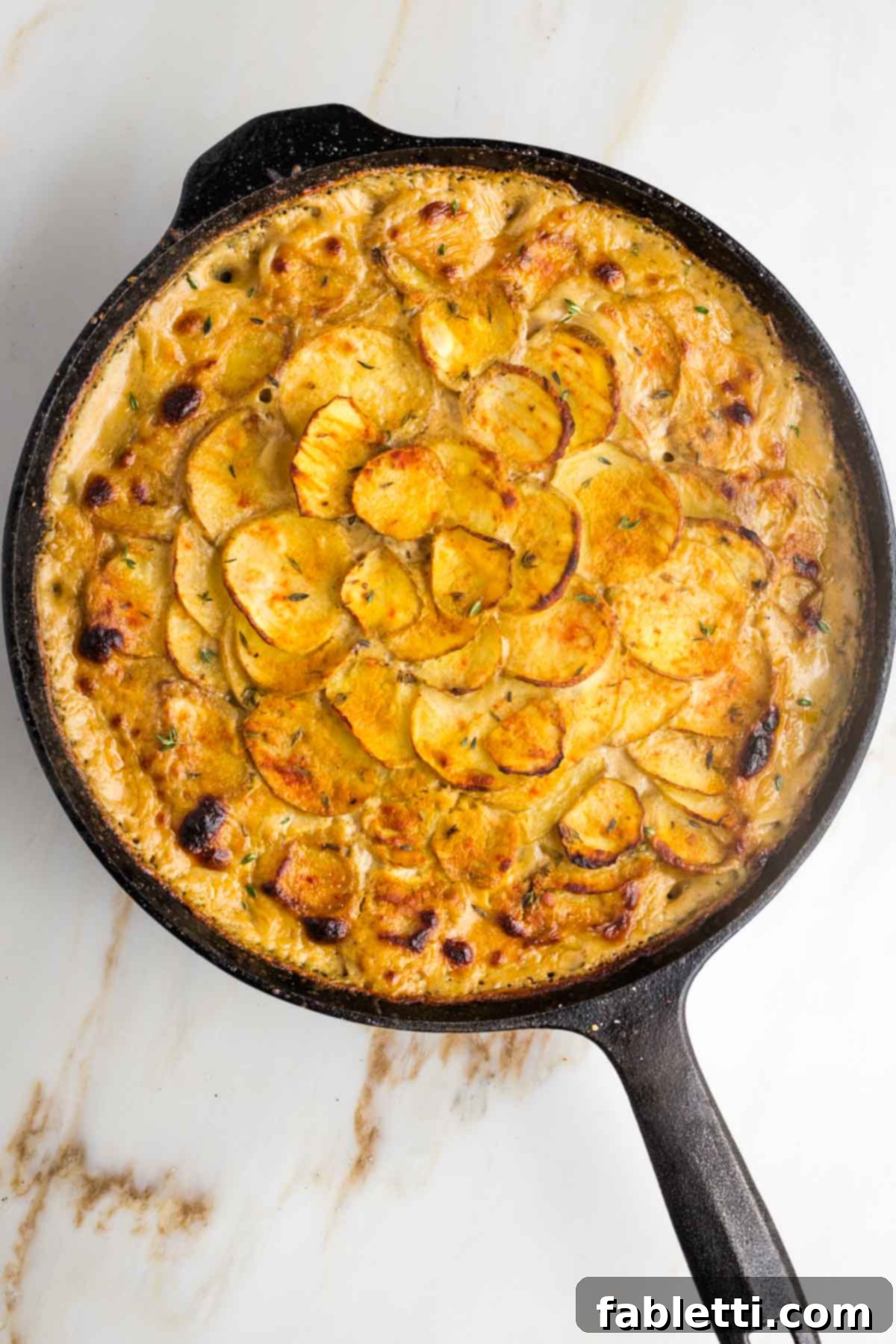
After the final bake, these dairy-free scalloped potatoes emerge from the oven beautifully crisped, with a golden-brown top, proving that plant-based dishes can be just as satisfying and visually appealing as their traditional counterparts.
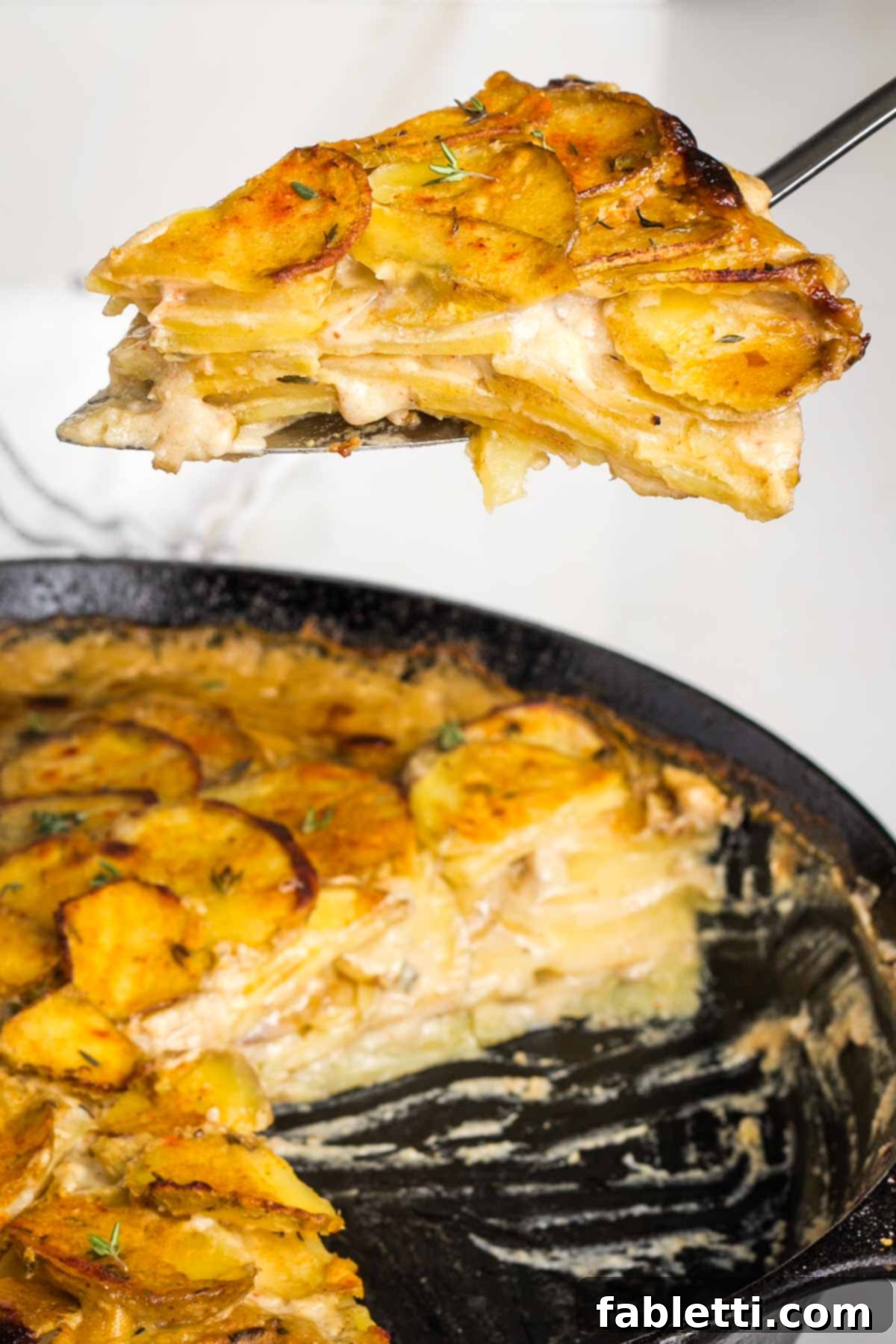
Once baked to perfection, use a sharp knife to carefully cut the scalloped potatoes into neat slices, or simply scoop out generous portions with a large spoon, ready to be enjoyed.
Debra’s Pro Tips for Dairy-Free Scalloped Potato Perfection
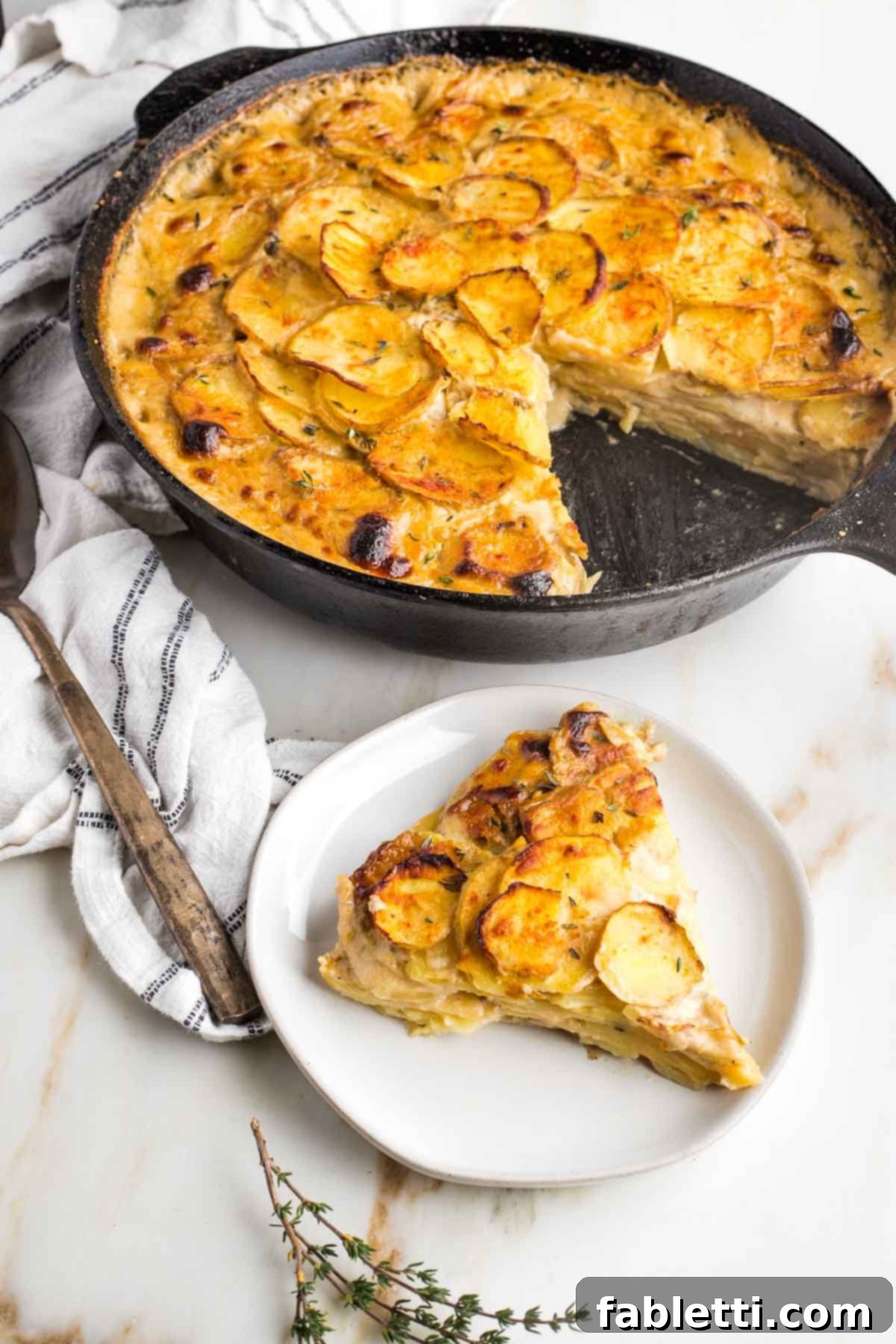
Achieving truly outstanding dairy-free scalloped potatoes is within your reach with these expert tips:
- Patience with the Sauce: The vegan white sauce, or béchamel, is the backbone of this dish. It typically takes 5-10 minutes to reach its ideal consistency. Keep your heat at medium-low and cultivate a bit of patience as it gradually thickens. The key is to add the liquid slowly, alternating between broth and plant milk, whisking constantly after each addition to ensure a perfectly smooth and lump-free sauce. Don’t rush this crucial step.
- The Miso Magic: Diluting the miso paste in a small amount of plant milk or broth before adding it to the main sauce is a critical step. This ensures it disperses evenly and fully incorporates, unleashing its full umami potential. Miso is truly the “secret” ingredient that infuses this vegan sauce with such a profound savory flavor, eliminating any need for traditional ham or other non-vegan flavor enhancers. It’s a game-changer!
- Baking Dish Flexibility: While a cast iron skillet offers fantastic heat distribution and a charming rustic presentation, this recipe is incredibly adaptable. You can absolutely use a standard 9×13 inch baking dish. When using a rectangular dish, simply layer the potato slices in neat rows across the dish, then create a second set of rows in the opposite direction for the next layer. This cross-hatch pattern yields the same delicious, beautifully layered results.
- Versatility Beyond Thanksgiving: These dairy-free scalloped potatoes are a star side dish for Thanksgiving, but their appeal extends far beyond holiday tables. They make a fabulous addition to any brunch menu, offering a hearty and comforting option. Furthermore, they are excellent for meal prepping; in fact, many find their flavors deepen and improve upon reheating, making them an ideal make-ahead component for busy weeks.
Serve, Store, and Reheat: Maximizing Your Scalloped Potato Enjoyment

These dairy-free scalloped potatoes are not only delightful fresh from the oven but also surprisingly versatile for future meals:
- Serving Suggestions: These creamy potatoes pair wonderfully with a wide array of main courses. Serve them alongside hearty plant-based proteins such as BBQ tofu and veggies, a savory vegan meatloaf, umami-rich miso mushrooms, or flavorful tofu satay. For a refreshing counterpoint, a crisp and simple lemony arugula salad completes the meal beautifully.
- Storing Leftovers: To maintain freshness and flavor, ensure any leftover scalloped potatoes are completely cooled before transferring them to an airtight container. Cover tightly and store them in the refrigerator, where they will remain delicious for up to 5 days.
- Reheating for Optimal Taste: To reheat, preheat your oven to 325 degrees Fahrenheit (160°C). Place the scalloped potatoes in an oven-safe dish and bake for approximately 30 minutes, or until thoroughly heated through and bubbling. If you’ve allowed the dish to come to room temperature before reheating, it may be ready in about 20 minutes. Covering loosely with foil during reheating can help prevent the top from drying out if preferred.
- Freezing for Future Meals: These dairy-free scalloped potatoes are an excellent candidate for meal prepping and freezing. If planning to freeze, consider baking them in a 9×13 inch or an 8 or 9-inch square baking pan for easier storage. Once baked, allow the dish to cool completely. Then, cover it tightly with aluminum foil and transfer it to the freezer. It will maintain its quality for up to 3 months. To enjoy, thaw the frozen potatoes in the refrigerator overnight, then reheat as suggested above for a comforting meal ready in no time.
Did you know commenting and rating recipes is one of the best ways to support your favorite food bloggers? If you made this recipe, please consider a five-star rating below and leave a comment. Also, please share your photos on instagram by tagging me @dkhealthcoach and using the hashtag #debraklein
📖 The Complete Recipe: Dairy-Free Scalloped Potatoes (Gluten-Free)

Dairy-free Scalloped Potatoes (gluten-free)
Author: Debra Klein
Creamy Dairy-Free Scalloped Potatoes Recipe is layered with tender potatoes and savory vegan béchamel and spices. This casserole-style potato dish is baked to perfection with a crispy top, making it ideal for meal prep, a delicious side dish for Thanksgiving, or a fantastic addition to any breakfast or brunch to wow everyone!
Print Recipe | Pin Recipe
Key Details
- Prep Time: 15 mins
- Cook Time: 1 hr
- Total Time: 1 hr 15 mins
- Course: Side Dish
- Cuisine: American, French
- Servings: 6
- Calories: 301 kcal
Equipment
- 10-inch Cast Iron Skillet
- Mandoline Slicer
- OXO Good Grips 11-Inch Balloon Whisk
Ingredients
For the Scalloped Potatoes:
- 3 lbs. yellow potatoes (such as Yukon Gold or Russet)
- ¼ cup olive oil
- ¼ cup cassava flour
- 3 cloves garlic, finely grated
- 1 ½ cups almond milk (or other neutral plant milk)
- 1 cup vegetable broth
- 1 teaspoon sea salt, divided
- 1 teaspoon paprika, divided
- ¼ teaspoon black pepper, divided
- 1 tablespoon miso paste
- 4 sprigs fresh thyme (or other fresh herbs)
- 1 tablespoon nutritional yeast
Instructions
Creamy Vegan White Sauce
- Set aside a couple tablespoons of plant milk (or veggie broth) and dissolve 1 tablespoon miso paste into it using a fork until smooth.
- Heat olive oil in a cast iron skillet over medium-low heat. Whisk in cassava flour until it turns into a thick paste (roux).
- Pour in about ¼ cup of veggie broth and continue whisking. Then add the grated garlic and stir constantly for about 30 seconds until fragrant.
- Alternate between adding ¼ cup of broth and ¼ cup of plant milk at a time, whisking well after each addition until the sauce has thickened. Once all liquid is incorporated, stir in the miso mixture plus half the paprika, half the salt, and half the pepper.
- Whisk well until everything is incorporated and the sauce is thick and creamy. Pour the finished white sauce into a separate bowl or measuring cup (you’ll have just under 3 cups).
Layer Potatoes
- Preheat oven to 350°F (175°C). Wash potatoes and scrub well (no need to peel). Slice potatoes into ⅛” thickness using a mandoline, food processor, or knife.
- Use the same skillet for layering. Lay a circle of overlapping potato slices against the outer edge of the skillet. Continue in an overlapping spiral pattern towards the center. Sprinkle with ⅓ of the remaining salt, pepper, paprika, and some fresh thyme. Pour about ¾ cup of the sauce onto the potatoes, then sprinkle with a teaspoon of nutritional yeast.
- Repeat layering with potatoes, spices, sauce, and nutritional yeast until all supplies have been used. The top layer should be sauce and nutritional yeast.
Bake
- Cover the skillet tightly with foil and bake in the preheated 350°F (175°C) oven for 45 minutes. The sauce will be bubbling, and potatoes will be tender.
- Remove foil, increase oven temperature to 450°F (230°C), and bake uncovered for an additional 15 minutes to crisp up the top. Check for tenderness with a fork; if needed, bake for another 5 minutes.
- Let rest for a few minutes before serving. Slice with a sharp knife or scoop out with a large spoon.
Notes
Potatoes: Yukon Gold, Russet, yellow creamer, or other similar starchy potatoes work well. Yams or standard yellow flesh sweet potatoes can also be used for a delicious result. Avoid purple or white sweet potatoes as they tend to be too dry for this recipe.
Flour: I used cassava flour for its neutral taste, gluten-free nature, and nutritional benefits (more protein and fiber). You can substitute with any all-purpose flour that suits your dietary needs.
Vegetable Broth: If using store-bought broth instead of my homemade veggie broth recipe, check the sodium content carefully. Many commercial broths are high in sodium, so you may need to reduce or omit the added salt in this potato recipe.
Milk: Any non-dairy milk will work. Choose soy, cashew, almond, or oat milk based on your preference and dietary requirements.
Fresh Thyme: Substitute with any fresh herbs like parsley, oregano, or basil. If fresh herbs are unavailable, use 1 tablespoon of dried Italian spices, sprinkling generously between potato layers along with other seasonings.
Nutrition
Calories: 301 kcal | Carbohydrates: 47g | Protein: 6g | Fat: 11g | Saturated Fat: 1g | Polyunsaturated Fat: 2g | Monounsaturated Fat: 7g | Sodium: 589mg | Potassium: 999mg | Fiber: 6g | Sugar: 2g | Vitamin A: 203IU | Vitamin C: 46mg | Calcium: 110mg | Iron: 2mg
Note
The nutrition calculations were done using online tools. To obtain the most accurate representation of the nutritional information in any given recipe, you should calculate the nutritional information with the actual ingredients you used. You are ultimately responsible for ensuring that any nutritional information is accurate, complete and useful.
Did you make this recipe? Please leave a review below, then snap a picture and tag me @dkhealthcoach or use hashtag #dkhealtcoach on Instagram so I can see it!!
